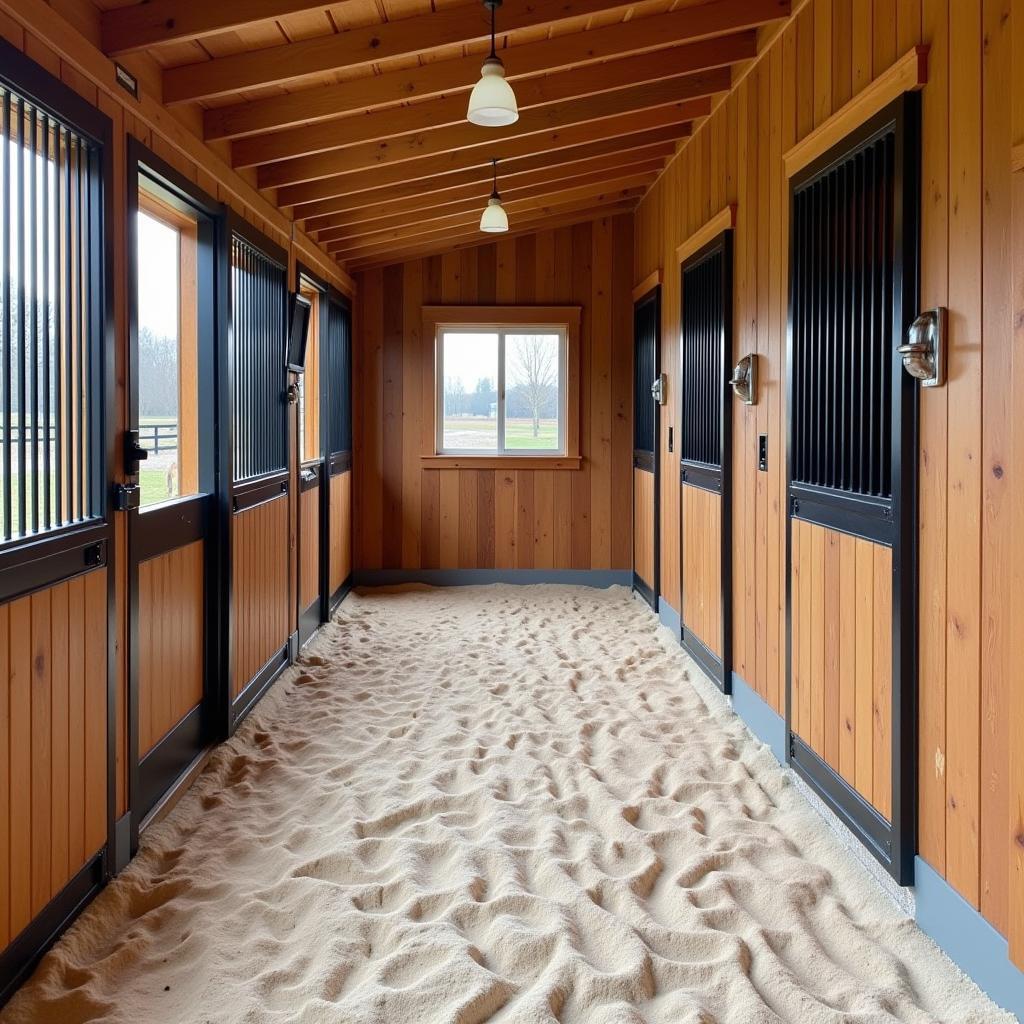Choosing the right bedding for your horse’s stall is crucial for their health, comfort, and overall well-being. While there are many options available, sand remains a popular choice among horse owners and for good reason. This comprehensive guide will delve deep into the world of Sand For Horse Stalls, covering everything from the benefits and drawbacks to the different types available and how to choose the best option for your equine companion.
 Horse stall with sand bedding
Horse stall with sand bedding
Why Choose Sand for Horse Stalls?
Sand offers a host of advantages over other bedding materials, making it a top contender for discerning horse owners:
- Superior Support and Cushioning: Unlike some bedding materials that can become compacted and hard, sand provides consistent support and cushioning for your horse’s joints and hooves. This is particularly beneficial for horses recovering from injuries, prone to lameness, or spending long periods in their stalls.
- Reduced Respiratory Issues: Sand produces minimal dust, making it an excellent option for horses with respiratory problems. Traditional bedding materials like straw or shavings can release dust particles that irritate sensitive airways, potentially leading to coughs or even heaves.
- Easy to Clean: Cleaning a sand stall is a breeze compared to other bedding types. Simply remove manure and wet spots daily, and the remaining sand can be easily leveled and reused. This efficiency can save you time and money in the long run.
- Cost-Effective: While the initial investment for a sand stall might seem higher than other options, the long-term cost can be significantly lower. Sand is durable and requires less frequent replacement, resulting in savings on bedding material and labor costs.
Navigating the World of Sand: Understanding the Different Types
Not all sand is created equal, especially when it comes to horse stalls. Here’s a breakdown of the most common types of sand used for horse bedding:
- Washed Sand: As the name suggests, washed sand undergoes a thorough cleaning process to remove impurities like silt, clay, and salt. This is crucial as these particles can contribute to dust, mud, and even health problems in horses if ingested.
- Screened Sand: This type of sand is passed through different sized screens to achieve a specific particle size and consistency. Ideally, you want sand that is coarse enough to provide drainage but fine enough to offer comfortable cushioning.
- Construction-Grade Sand: While readily available and generally less expensive, construction-grade sand is not recommended for horse stalls. It is often contaminated with other materials and can be too fine, leading to drainage issues and potential compaction.
Choosing the Right Sand: Factors to Consider
Selecting the best sand for your horse’s stall depends on several factors:
- Your Horse’s Needs: Consider your horse’s age, breed, health condition, and activity level. Older horses or those with joint issues will benefit from finer sand, while younger, more active horses might prefer a coarser texture.
- Climate: If you live in a humid environment, prioritize sand with excellent drainage to prevent moisture buildup and bacterial growth. Drier climates might allow for slightly finer sand options.
- Availability and Budget: While it’s essential to prioritize quality, consider the availability and cost of different sand types in your area.
Maintaining Your Sand Stall: Tips for Optimal Hygiene and Longevity
Proper maintenance is crucial for maximizing the benefits of a sand stall and ensuring your horse’s well-being:
- Daily Cleaning: Remove manure and wet spots at least once a day using a manure fork and shovel. This prevents ammonia buildup and minimizes bacterial growth.
- Regular Raking and Leveling: Use a stall rake to level the sand and prevent compaction. This promotes even wear and ensures proper drainage.
- Periodic Deep Cleaning: Every few months, remove all bedding from the stall and thoroughly clean the floor. This allows you to inspect for any drainage issues and start fresh with clean sand.
Expert Insights: What the Pros Say About Sand Bedding
“I’ve been using sand in my horse stalls for years, and it’s made a world of difference,” says renowned equine veterinarian Dr. Sarah Miller. “My patients, especially those with respiratory issues or joint problems, have shown significant improvement since switching to sand. It’s a game-changer.”
Conclusion: Embracing Sand for a Healthier, Happier Horse
Choosing the right bedding is a fundamental aspect of responsible horse ownership. Sand, with its numerous benefits for both horses and owners, emerges as a compelling choice. By understanding the different types, carefully selecting the best option for your horse, and implementing proper maintenance practices, you can provide your equine companion with a comfortable, healthy, and supportive environment that promotes their overall well-being.
For more insights on horse care and stable management, explore our other informative articles like horse lean to kits and horse garland.
Need expert advice on building a new horse barn or upgrading your existing facilities? Contact us today at 0772127271 or [email protected]. Our team at Justus Horses USA is dedicated to providing you with top-notch solutions and unparalleled customer service. Visit us at QGM2+WX2, Vị Trung, Vị Thuỷ, Hậu Giang, Việt Nam. We’re here to help you create the perfect environment for your beloved equine partners.